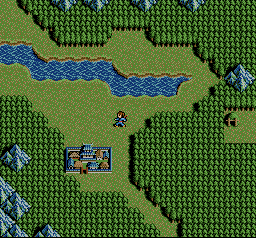 ... ...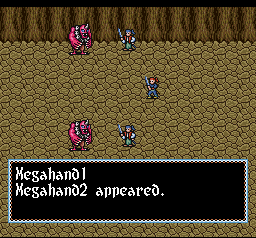
Inindo has proven to me something that I've known for years: Only great RPGs are fun to replay. RPGs that are just good tend to lose some of their appeal. Although many people say that RPGs, as a genre, don't have much replay value, I've never really agreed with that. I've played and replayed Final Fantasy 4, Final Fantasy 6, Breath of Fire, Chrono Trigger, Earthbound, Arcana and Super Mario RPG many times and have never gotten bored with them. But with other RPGs that have only a few new ideas, it's easy to be so impressed with those ideas the first time you play that you overlook the problems. On a replay, when those ideas are no longer new to you, the flaws begin to stand out.
Set in medieval Japan, Inindo begins with a haunting sequence that outlines Oda Nobunaga's tyranny and persecution of the Iga people. The hero, who has been training to become a ninja, is drawn into the battle against Nobunaga when his village is destroyed. The hero would have also been killed, if news had not arrived to the soldiers that Nobunaga was attacked and mortally wounded at Honnoji Temple. The troops withdraw, and the hero sets out on a mission to complete his training and get revenge.
I admit that I don't know much about Japanese history, and I only just started reading some about Oda Nobunaga after playing this game. In reality, Nobunaga died in the attack on Honnoji Temple that day in 1582, assassinated by one of his own generals. In the game, he survives the attack and even gains magical powers from it. Inindo is a "what-if" scenario, presumably to provide closure and proper revenge for the Iga people. Goofy? Yes.
 ... ...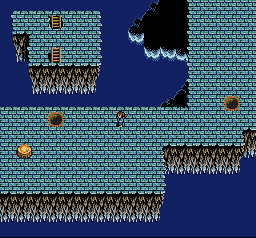
Inindo observes the RPG tradition that training always takes the form of walking through dungeons and fighting random battles, no matter what you're training to be. You'd think if you were training to be a ninja, you'd be learning ninjutsu, swordplay, and the art of stealth from some wise master, but never mind. After learning from quasi-direction blind townspeople where to go, you jog off to that dungeon (it's a good thing your hero can travel across all of Japan in about a minute), and there you search for a hidden object that will grant you use of some magic spells. The dungeons are often sprawling, complex mazes, and some even contain a few puzzles to which you're given cryptic clues for as you walk about. I was particularly confounded by one puzzle in which I reached a dead-end in a room full of teleportation pads. There appeared to be no way to move on, until I finally figured out what was happening. Puzzles like that are becoming such a rarity in RPGs nowadays, that I appreciate them when they exist, and commend them when they actually stump me.
Dungeons are full of random Final Fantasy-style battles, but Inindo has a unique twist: You can move your characters around the playing field via a crude grid system. You cannot attack an enemy with a sword unless you are on a grid square adjacent to it. You can only attack from a distance with projectiles and magic. This introduces an element of strategy. Most often I found myself using the same one, but at least it kept me busy. If an RPG's battle system can't be exhilarating, then I at least ask that it not bore me. For the most part, Inindo's did not, but there is a problem with the game's pacing that's directly related to it.
Inindo's pace is comparable to driving down a street with a lot of stoplights: Once you've reached a certain experience level, you'll be able to blaze through the next few dungeons with ease. Then you'll come to a dungeon where the enemies are way too difficult for you to handle without some level building. This didn't bother me very much the first time I played. The level building isn't excessive, and usually just a matter of 2 or 3 levels can make a huge difference. (I first beat the game at Level 51 and I had to use an airtight strategy against the final boss. The second time, I beat it at Level 53 and the final boss was much easier.) On my replay, when I'd reach one of these "traffic stops", I'd put the game away for a day or two before picking it up again to build levels - a fact that might deter me from ever wanting to play the game again. This is mostly because the battles can take quite a few rounds to end until you're strong enough to beat enemies in one or two hits.
 ... ...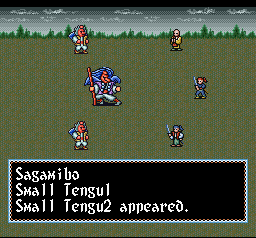
One thing that could've made Inindo more interesting on replays are the dozens of recruitable characters. The five types are the Warrior Class (Samurai, Swordsman, Ronin), the Wizard Class (Sorcerer, Mystic, Magician), the Healer Class (Hermit, Mendicant, Sohei, Sage), and the Ninja Class (Koga, Iga, Negoro, Fuma). However, I find little reason to play with anything other than a Samurai and one of the Healer Class as my back-up characters. Other ninjas and warriors are too weak to bother with, and I can't imagine playing without a healer because of the extremely limited number of items you can carry. At least if you played without a healer in Final Fantasy, you could carry 99 healing potions. Not here. If only more work had been done to make the character classes more diverse and useful, the replay value could've been phenomenal. It's as though game developers sometimes have great ideas right under their noses, but don't realize it.
Inindo is also one of the most unprofessional looking and sounding games I've ever played. I'd say that the overworld, dungeon, and town graphics look like something that belongs on the NES, except that I've seen NES RPGs that looked far better. One thing I do like about the graphics are the enemies. They are based on traditional Japanese monsters, like ogres, tengus, and strange spirits, so they look a lot different than the enemies in most any other RPG. They are also animated, and some even have a separate animation for attack and magic. The animation isn't spectacular, but animated enemies were such a rarity in RPGs back when Inindo was made, that I can easily appreciate them. The music, which is a stilted attempt at sounding like traditional Japanese instruments, is sometimes passable (town and overworld themes), but often grating and obnoxious (dungeon and battle themes). You are likely to feel visually and aurally assaulted when you first play Inindo, but it is possible to get past it.
I hope I'm not making Inindo sound worse than it actually is. There is a lot going for this game, otherwise I wouldn't have enjoyed it as much as I did the first time through. One thing that particularly impressed me about the game world, despite how unimpressive it looks, is how it seemed to have a life of its own. Recruitable characters often don't stay in the same towns where you meet them. They travel around, and sometimes you'll meet them, and even fight them, on the overworld. Character dialogue is written with a similar tongue-in-cheek humor to that of the Shadowgate series. Although the mandatory dungeons must be completed in a specific order, the world is non-linear, and you can explore all of Japan's towns and optional dungeons at your leisure. Most bosses are optional, but you'll probably want to beat them anyway to gear up for tougher obstacles, and some of them are quite comical, like the great Tengu, Sagamibo. There are other little humorous bits, such as when your ninja attempts to sabotage a castle, but fails and falls off the side. I laughed quite a bit at that.
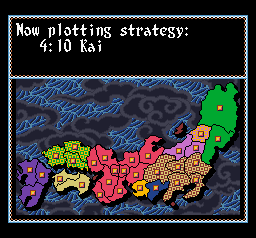 ... ...
Time passes as you move about the overworld, and on the first of each month, Inindo plans out strategies for the various warring territories of Japan. This is your key to accessing the final area and one of the best parts of the game. By gaining trust in an emperor, you can join in these battles, which require much more planning and strategy than the normal enemy encounters. These battles are very fun and addictive because the immediate rewards are so much greater than what you'd get after a normal battle - a party may conquer a nice large chunk of Japan if it wins. Unfortunately, I discovered something on my replay that also convinced me that Inindo was not as good as I had originally thought: Careful use of the Blaze spell will grant you victory every time.
It's a good thing I don't review RPGs immediately after finishing them the first time. I still think Inindo is a decent game with a lot of good ideas. Its dungeons are more fun than many RPG's that I've slogged through which had no puzzles or level design of any kind. And I enjoyed the game's unexpected humor. It's worth playing through once, but just doesn't entertain as much on replays.
OVERALL
SCORE: 6.5/10
BACK
TO SUPER NES REVIEWS
BACK
TO MAIN PAGE
|



